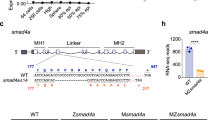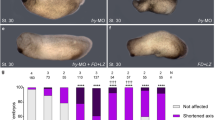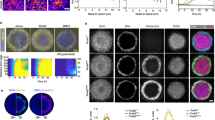Abstract
During embryogenesis, inductive interactions underlie the development of much of the body plan. In Xenopus laevis, factors secreted from the vegetal pole induce mesoderm in the adjacent marginal zone; members of both the transforming growth factor-β (TGF-β) and fibroblast growth factor (FGF) ligand families seem to have critical roles in this process1. Here we report the identification and characterization of laloo, a novel participant in the signal transduction cascade linking extracellular, mesoderm-inducing signals to the nucleus, where alteration of cell fate is driven by changes in gene expression. Overexpression of laloo, a member of the Src-related gene family, in Xenopus embryos gives rise to ectopic posterior structures that frequently contain axial tissue. Laloo induces mesoderm in Xenopus ectodermal explants; this induction is blocked by reagents that disrupt the FGF signalling pathway. Conversely, expression of a dominant-inhibitory Laloo mutant blocks mesoderm induction by FGF and causes severe posterior truncations in vivo. This work provides the first evidence that a Src-related kinase is involved in vertebrate mesoderm induction.
This is a preview of subscription content, access via your institution
Access options
Subscribe to this journal
Receive 51 print issues and online access
$199.00 per year
only $3.90 per issue
Buy this article
- Purchase on Springer Link
- Instant access to full article PDF
Prices may be subject to local taxes which are calculated during checkout




Similar content being viewed by others
References
Klein, P. S. & Melton, D. A. Hormonal regulation of embryogenesis: the formation of mesoderm in Xenopus laevis. Endocr. Rev. 15, 326–341 (1994).
Brown, M. T. & Cooper, J. A. Regulation, substrates and functions of src. Biochim. Biophys. Acta 1287, 121–149 (1996).
Smith, J. C., Price, B. M. J., Green, J. B. A., Weigel, D. & Herrmann, B. G. Expression of a Xenopus homolog of Brachyury (T) is an immediate-early response to mesoderm induction. Cell 67, 79–87 (1991).
Smith, W. C. & Harland, R. M. Injected Xwnt-8 RNA acts early in Xenopus embryos to promote formation of a vegetal dorsalizing center. Cell 67, 753–765 (1991).
Sasai, Y., Lu, B., Steinbeisser, H., Geissert, D., Gont, L. K. & DeRobertis, E. M. Xenopus chordin: a novel dorsalizing factor activated by organizer-specific homeobox genes. Cell 79, 779–790 (1994).
Wright, C. V. E., Morita, E. A., Wilkin, D. J. & DeRobertis, E. M. The Xenopus X1Hbox6 homeo protein, a marker of posterior neural induction, is expressed in proliferating neurons. Development 109, 225–234 (1990).
Kintner, C. R. & Melton, D. A. Expression of Xenopus NCAM RNA in ectoderm is an early response to neural induction. Development 99, 311–325 (1987).
Mohun, T. J., Brennan, S., Dathan, N., Fairman, S. & Gurdon, J. B. Cell type-specific activation of actin genes in the early amphibian embryo. Nature 311, 716–721 (1984).
Lagna, G., Hata, A., Hemmati-Brivanlou, A. & Massague, J. Partnership between DPC4 and SMAD proteins in TGF-β signalling pathways. Nature 383, 832–836 (1996).
Amaya, E., Musci, T. J. & Kirschner, M. W. Expression of a dominant negative mutant of the FGF receptor disrupts mesoderm formation in Xenopus embryos. Cell 66, 257–270 (1991).
Whitman, M. & Melton, D. A. Involvement of p21ras in Xenopus mesoderm induction. Nature 357, 252–255 (1992).
MacNicol, A. M., Muslin, A. J. & Williams, L. T. Raf-1 kinase is essential for early Xenopus development and mediates the induction of mesoderm by FGF. Cell 73, 571–584 (1993).
LaBonne, C. & Whitman, M. Mesoderm induction by activin requires FGF-mediated intracellular signals. Development 120, 463–472 (1994).
LaBonne, C., Burke, B. & Whitman, M. Role of MAP kinase in mesoderm induction and axial patterning during Xenopus development. Development 121, 1475–1486 (1995).
Gotoh, Y., Masuyama, N., Suzuki, A., Ueno, N. & Nishida, E. Involvement of the MAP kinase cascade in Xenopus mesoderm induction. EMBO J. 14, 2491–2498 (1995).
Umbhauer, M., Marshall, C. J., Mason, C. S., Old, R. W. & Smith, J. C. Mesoderm induction in Xenopus caused by activation of MAP kinase. Nature 376, 58–62 (1995).
Northrop, J. et al. BMP-4 regulates the dorsal-ventral differences in FGF/MAPKK-mediated mesoderm induction in Xenopus. Dev. Biol. 172, 242–252 (1995).
Amaya, E. & Kroll, K. L. Transgenic Xenopus embryos from sperm nuclear transplantations reveal FGF signaling requirements during gastrulation. Development 122, 3173–3183 (1996).
Cornell, R. A. & Kimelman, D. Activin-mediated mesoderm induction requires FGF. Development 120, 453–462 (1994).
Tang, T. L., Freeman, R. M. J, O'Reilly, A. M., Neel, B. G. & Sokol, S. Y. The SH2-containing protein-tyrosine phosphatase SH-PTP2 is required upstream of MAP kinase for early Xenopus development. Cell 80, 473–483 (1995).
LaBonne, C. & Whitman, M. Localization of MAP kinase activity in early Xenopus embryos: implications for endogenous FGF signaling. Dev. Biol. 183, 9–20 (1997).
Isaacs, H. V., Pownall, M. E. & Slack, J. M. W. eFGF regulates Xbra expression during Xenopus gastrulation. EMBO J. 13, 4469–4481 (1994).
Schulte-Merker, S. & Smith, J. C. Mesoderm formation in response to Brachyury requires FGF signaling. Curr. Biol. 5, 62–67 (1995).
Parsons, J. T. & Parsons, S. J. Src family protein tyrosine kinases: cooperating with growth factor and adhesion signaling pathways. Curr. Opin. Cell Biol. 9, 187–192 (1997).
Lustig, K. D., Kroll, K. L., Sun, E. E. & Kirschner, M. W. Expression cloning of a Xenopus T-related gene (Xombi) involved in mesodermal patterning and blastopore lip formation. Development 122, 4001–4012 (1996).
Hemmati-Brivanlou, A. & Melton, D. A. Inhibition of activin receptor signaling promotes neuralization in Xenopus. Cell 77, 273–281 (1994).
Harris, W. A. & Hartenstein, V. Neuronal determination without cell division in Xenopus embryos. Neuron 6, 499–515 (1991).
Kintner, C. R. & Brockes, J. P. Monoclonal antibodies identify blastemal cells derived from dedifferentiating muscle in newt limb regeneration. Nature 308, 67–69 (1984).
Krieg, P., Varnum, S., Wormington, M. & Melton, D. A. The mRNA encoding elongation factor 1α (EF-1α) is a major transcript at the mid-blastula transition in Xenopus. Dev. Biol. 133, 93–100 (1989).
Bassez, T., Paris, J., Omilli, F., Dorel, C. & Osborne, H. B. Post-transcriptional regulation of ornithine decarboxylase in Xenopus laevis oocytes. Development 110, 955–962 (1990).
Acknowledgements
We thank M. Whitman and E. Amaya for providing us with the Ras and XFD constructs, respectively; W. Harris for the 6F11 antibody; and members of the laboratory, P. Wilson and H. Hanafusa, for critical reading of the manuscript. F.C. received partial financial support from Programma Scambi Internazionali and Piano Bilaterale of CNR of Rome. A.H.-B. is a Merck and a McKnight scholar. This work was supported by NIH grant HD 32105-01 and by grants from the Klingenstein and Merck Foundations to A.H.-B.
Author information
Authors and Affiliations
Corresponding author
Rights and permissions
About this article
Cite this article
Weinstein, D., Marden, J., Carnevali, F. et al. FGF-mediated mesoderm induction involves the Src-family kinase Laloo. Nature 394, 904–908 (1998). https://doi.org/10.1038/29808
Received:
Accepted:
Issue Date:
DOI: https://doi.org/10.1038/29808
This article is cited by
-
Precardiac organoids form two heart fields via Bmp/Wnt signaling
Nature Communications (2018)
-
Inhibition of c-Yes induces differentiation of HT-29 human colon cancer stem cells through midbody elongation
Tissue Engineering and Regenerative Medicine (2016)
-
Molecular specification of germ layers in vertebrate embryos
Cellular and Molecular Life Sciences (2016)
-
Oncogenic Met receptor induces ectopic structures in Xenopus embryos
Oncogene (2006)
-
Identification of Sef, a novel modulator of FGF signalling
Nature Cell Biology (2002)
Comments
By submitting a comment you agree to abide by our Terms and Community Guidelines. If you find something abusive or that does not comply with our terms or guidelines please flag it as inappropriate.



